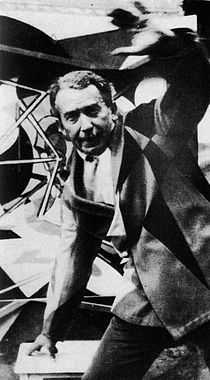Giacomo Balla
| Giacomo Balla | |
|---|---|
 | |
| Born |
July 18, 1871 Turin, Italy |
| Died |
March 1, 1958 (aged 86) Rome, Italy |
| Nationality | Italian |
| Known for | Painting, Poet |
| Movement | Futurism |
Giacomo Balla (July 18, 1871 – March 1, 1958) was an art teacher, painter and poet and participated later in Futurism. In his art he created a pictorial depiction of light, movement and speed.
Biography
Born in Turin, in the Piedmont region of Italy, Balla was the son of a photographer [1] and as a child he studied music.
At 9, when his father died, he gave up music and began working in a lithograph print shop. Until age of twenty, his interest in art was such that he decided to study painting at local academies and exhibited several of his early works. Following academic studies at the University of Turin, Balla moved to Rome in 1895, where he met and married Elisa Marcucci. For several years he worked in Rome as an illustrator, a caricaturist, and also did portraiture. In 1899, his work was shown at the Venice Biennale, and in the ensuing years his art was on display at major Italian exhibitions in Rome and Venice. In Munich, Berlin,and Düsseldorf, Germany. Salon d'Automne in Paris, and galleries in Rotterdam, Netherlands.
%2C_Albright-Knox_Art_Gallery.jpg)
Around 1902, he taught Divisionist techniques to Umberto Boccioni and Gino Severini.[2] Influenced by Filippo Tommaso Marinetti, Giacomo Balla adopted the Futurism style, creating a pictorial depiction of light, movement and speed. He was signatory to the Futurist Manifesto in 1910, and began designing and painting Futurist furniture, also created Futurist "antineutral" clothing. In painting, his new style is demonstrated in Dynamism of a Dog on a Leash (1912). Seen here, is his 1914 work titled Abstract Speed + Sound (Velocità astratta + rumore). In 1914, Balla also began sculpting, and the year after, created the well-known sculpture, Boccioni's Fist.
During World War I, Balla's studio became the meeting place for young artists. By the end of the war, the Futurist movement showed signs of decline. In 1935, he was made a member of Rome's Accademia di San Luca. In 1955, Balla participated in the documenta 1 in Kassel, Germany.
He died on March 1, 1958.

Legacy
In 1987, his work was also shown postmortem during the documenta 8.
References
- ↑ ...], [contributors Rachel Barnes (2001). The 20th-Century art book. (Reprinted. ed.). London: Phaidon Press. ISBN 0714835420.
- ↑ Coen, Ester (1989). Umberto Boccioni. New York: The Metropolitan Museum of Art. p. 272. ISBN 0870995227.
Further reading
- Maurizio Fagiolo Dell'Arco, Balla: The Futurist (1988)
- Giovanni Lista, Balla, catalogue général de l’œuvre, vol. I, Edizioni della Galleria Fonte d’Abisso, Modène, 1982 ; vol. II, L’Age d’Homme, Lausanne, 1984
- Giovanni Lista,Le Futurisme : création et avant-garde, Éditions L’Amateur, Paris, 2001
- Giovanni Lista, Balla, la modernità futurista, Edizioni Skira, Milan, 2008
- Giovanni Lista, Giacomo Balla: futurismo e neofuturismo, Mudima, Milano, 2009.
- Giacomo Balla, Scritti futuristi, raccolti e curati da Giovanni Lista, Abscondita, Milan, 2010.
External links
| Wikiquote has quotations related to: Giacomo Balla |
- Guide to Balla's paintings, at Artcyclopedia
- Abstract Speed + Sound by Giacomo Balla, Guggenheim Museum
- Giacomo Balla's Biography- Guggenheim Museum
- Article on Italian Futurism exhibition at the Guggenheim Museum
|